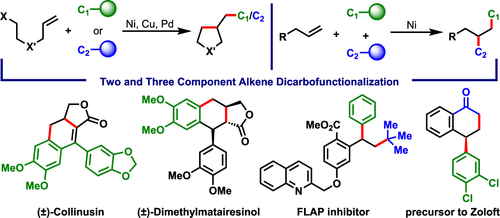当前位置:
X-MOL 学术
›
Acc. Chem. Res.
›
论文详情
Our official English website, www.x-mol.net, welcomes your
feedback! (Note: you will need to create a separate account there.)
Transition Metal (Ni, Cu, Pd)-Catalyzed Alkene Dicarbofunctionalization Reactions
Accounts of Chemical Research ( IF 16.4 ) Pub Date : 2021-08-12 , DOI: 10.1021/acs.accounts.1c00329 Laura M Wickham 1 , Ramesh Giri 1
Accounts of Chemical Research ( IF 16.4 ) Pub Date : 2021-08-12 , DOI: 10.1021/acs.accounts.1c00329 Laura M Wickham 1 , Ramesh Giri 1
Affiliation

|
Recently, alkene dicarbofunctionalization, i.e., the powerful organic synthesis method of alkene difunctionalization with two carbon sources, emerged as a formidable reaction with immense promise to synthesize complex molecules expeditiously from simple chemicals. This reaction is generally achieved with transition metals (TMs) through interception by carbon sources of an alkylmetal [β-H–C(sp3)–[M]] species, a key intermediate prone to undergo rapid β-H elimination. Related prior reports, since Paolo Chiusoli and Catellani’s work in 1982 [ Tetrahedron Lett. 1982, 23, 4517], have used bicyclic and disubstituted terminal alkenes, wherein β-H elimination is avoided by geometric restriction or complete lack of β-H’s. With reasoning that β-H–C(sp3)–[M] intermediates could be rendered amenable to interception with the use of first row late TMs and formation of coordination-assisted transient metallacycles, these two strategies were implemented to address the β-H elimination problem in alkene dicarbofunctionalization reactions.
中文翻译:

过渡金属(Ni、Cu、Pd)催化的烯烃二碳官能化反应
最近,烯烃二碳官能化,即用两种碳源进行烯烃双官能化的强大有机合成方法,作为一种强大的反应出现,有望从简单的化学物质迅速合成复杂的分子。该反应通常通过过渡金属 (TM) 通过烷基金属 [β-H-C(sp 3 )-[M]] 物种的碳源拦截来实现,该物种是一种易于快速消除 β-H 的关键中间体。相关的先前报道,自 1982 年 Paolo Chiusoli 和 Catellani 的工作 [ Tetrahedron Lett. 1982 , 23 , 4517],已经使用了双环和二取代的末端烯烃,其中通过几何限制或完全没有 β-H 来避免 β-H 消除。推理 β-H–C(sp3 )–[M] 中间体可以通过使用第一排晚期 TM 和形成配位辅助的瞬态金属环来进行拦截,这两种策略用于解决烯烃二碳官能化反应中的 β-H 消除问题。
更新日期:2021-09-07
中文翻译:

过渡金属(Ni、Cu、Pd)催化的烯烃二碳官能化反应
最近,烯烃二碳官能化,即用两种碳源进行烯烃双官能化的强大有机合成方法,作为一种强大的反应出现,有望从简单的化学物质迅速合成复杂的分子。该反应通常通过过渡金属 (TM) 通过烷基金属 [β-H-C(sp 3 )-[M]] 物种的碳源拦截来实现,该物种是一种易于快速消除 β-H 的关键中间体。相关的先前报道,自 1982 年 Paolo Chiusoli 和 Catellani 的工作 [ Tetrahedron Lett. 1982 , 23 , 4517],已经使用了双环和二取代的末端烯烃,其中通过几何限制或完全没有 β-H 来避免 β-H 消除。推理 β-H–C(sp3 )–[M] 中间体可以通过使用第一排晚期 TM 和形成配位辅助的瞬态金属环来进行拦截,这两种策略用于解决烯烃二碳官能化反应中的 β-H 消除问题。











































 京公网安备 11010802027423号
京公网安备 11010802027423号